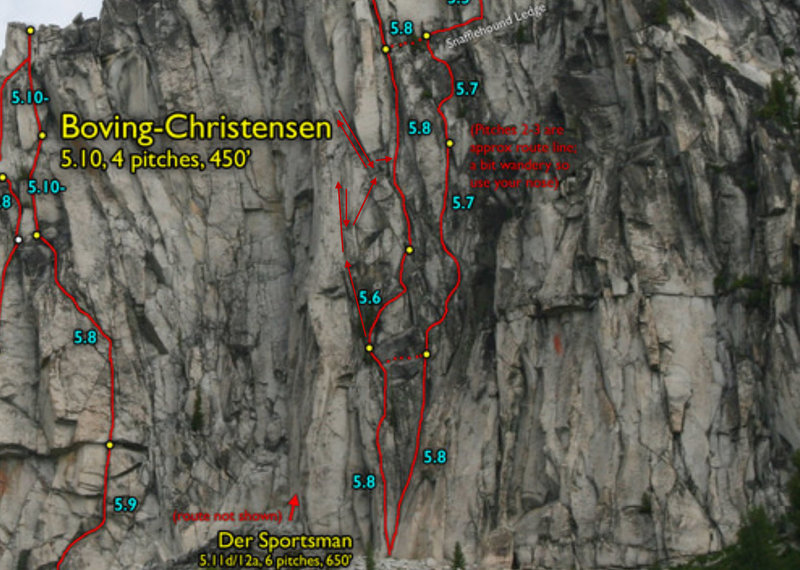



 Avg: 3.7 from 187
votes
Avg: 3.7 from 187
votes
The route goes up the south face of the peak. Traverse the lake until you find the start. Walk off the west face route or rappel the north side of the peak. Also beware of the snafflehounds. They will eat your shoes, gear, etc!!! Approx coords of P1: 47.48681, -120.78457












Fayetteville, NC
Portland, OR
Squamish, BC
Salt Lake City, UT
bozeman
South Lake Tahoe
Stone Ridge, NY
Be careful on rappel, there's lots of loose rocks waiting for your rope to knock off. We found shredded rope ends at the bottom - yikes. Aug 25, 2012
Casper, Wyoming
We hauled up two fours and a Five but didn't use them at all. I thought the whole route protected well on gear up to 3-3.5 inch piece, even the wide sections take small gear.
Beautiful piece of rock and so quality. I Definitely want to try to a car to car for the solid gold route. Aug 5, 2014
Bend, OR
Seattle, Washington
Seattle, WA
Centennial, CO
Seattle, WA
-Only found bits and pieces of the approach trail from the main snow lakes trail over to the base of the route. I think if you go all the way to where the trail cuts across the outlet of Lake Viviane, you've passed the trail up to the route.
-We were definitely not able to link P3 and P4 on a 60m rope. Seems unlikely even on a 70m. We ran "P3" into "P4" and ended up between 15-20m short of the belay ledge on top of the chockstone. Moved the belay up to be in good position for P5.
-Thought P5 and P6 are of similar difficulty, but very different styles. P5 protects well with (1) #4, but you could sew it up with more. Not sure I wanted anything wider.
-Took doubles from tips to #2, with (1) #3 and (1) #4 which felt about perfect.
-If there is snow in the range, P6 might not be fully dry. Makes it quite a bit spicier.
-If you are considering the car to car in a day option, the gradual grade of approaching from Snow Lakes TH is recommended. I found this much easier than going over Asgaard Pass. Sep 24, 2017
Bend, OR
CAUTION!
P6: Now has dangerous chockstones & choss in the first half.
The bottom half is a wider crack (the effected area), which brings you to the stunning splitter section (no choss here). A big rock fall must have happened, two days prior to when we climbed this, from a thunderstorm. Two people were on Prusik during the storm, who reported that heaps of rock fell down on them. This must be one of the effected areas.
I attempted to tip the large chockstone out after passing, yet I had trouble positioning myself from a place to lever it out. Little sand/debris held it in place. The debris is likely to wash out after another few storms, so be cautious. If the block is still there, and nobody at Pursik, please help to clean the route!
If you climb this after I did, and it the crack climbs safe, please note that for future users; thanks! Jun 27, 2018
Spokane, WA
And whatever you do, climb the 5.10b crack variation on pitch 4. It is some of the best crack climbing in the alpine I have done. I setup a belay below the chockstone and extended it down so it was in line with the traverse back over from the top of the crack. This reduced the rope drag a lot from trying to go all the way to the top of the chockstone. Jul 9, 2018
Beaverton, OR
Leavenworth, WA
Portland, OR
Bellingham, WA
I practiced the buttlips chimney on Aries in Index before doing Stanley Burgner, and it really helped.
Also, splitting the last pitch into two short pitches makes it easier to keep it well protected. The gear is amazing, but you'll run out of medium to large cams if you sew the whole pitch up, and it's pretty sustained. Jun 28, 2021
Seattle, Wa
pitch 5: felt much harder than pitch 6. Oct 4, 2021
Seattle, WA
youtube.com/shorts/gXMOnfZ3… Aug 21, 2022
Portland, OR
Princeton, NJ
I'm ~180lb and BARELY made it through the tunnel behind the chockstone.
The squeeze chimney is brutal, reminiscent of Epinephrine at Red Rocks but more flaring. 10- IMO. Jul 28, 2023